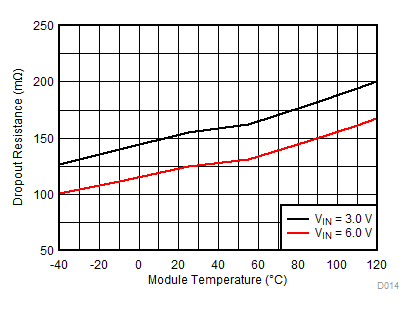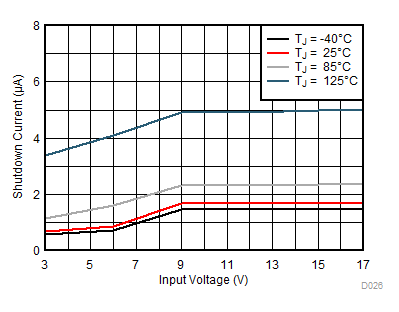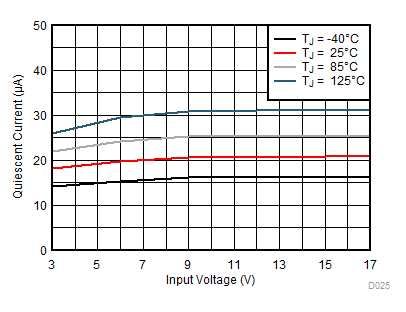ZHCSGD1 June 2017 TPS82140
PRODUCTION DATA.
- 1 特性
- 2 应用
- 3 说明
- 4 修订历史记录
- 5 Pin Configuration and Functions
- 6 Specifications
- 7 Detailed Description
- 8 Application and Implementation
- 9 Power Supply Recommendations
- 10Layout
- 11器件和文档支持
- 12机械、封装和可订购信息
6 Specifications
6.1 Absolute Maximum Ratings(1)
| MIN | MAX | UNIT | ||
|---|---|---|---|---|
| Voltage at pins(2) | VIN | -0.3 | 20 | V |
| EN, SS/TR | -0.3 | VIN + 0.3 | ||
| PG, FB | -0.3 | 7 | ||
| VOUT | 0 | 7 | ||
| Sink current | PG | 10 | mA | |
| Module operating temperature | –40 | 125 | °C | |
| Storage temperature | –55 | 125 | °C | |
(1) Stresses beyond those listed under absolute maximum ratings may cause permanent damage to the device. These are stress ratings only, and functional operation of the device at these or any other conditions beyond those indicated under recommended operating conditions is not implied. Exposure to absolute-maximum-rated conditions for extended periods may affect device reliability.
(2) All voltage values are with respect to network ground pin.
6.2 ESD Ratings
| VALUE | UNIT | |||
|---|---|---|---|---|
| V(ESD) | Electrostatic discharge | Human body model (HBM), per ANSI/ESDA/JEDEC JS-001(1) | ±2000 | V |
| Charged device model (CDM), per JEDEC specification JESD22-C101(2) | ±1000 | |||
(1) JEDEC document JEP155 states that 500-V HBM allows safe manufacturing with a standard ESD control process.
(2) JEDEC document JEP157 states that 250-V CDM allows safe manufacturing with a standard ESD control process.
6.3 Recommend Operating Conditions
| MIN | MAX | UNIT | ||
|---|---|---|---|---|
| VIN | Input voltage | 3 | 17 | V |
| VPG | Power good pull-up resistor voltage | 6 | V | |
| VOUT | Output voltage | 0.9 | 6 | V |
| IOUT | Output current | 0 | 2 | A |
| TJ | Module operating temperature range for 100,000 hours lifetime(1) | -40 | 110 | °C |
(1) The module operating temperature range includes module self temperature rise and IC junction temperature rise. In applications where high power dissipation is present, the maximum operating temperature or maximum output current must be derated. For applications where the module operates continuously at 125 °C temperature, the maximum lifetime is reduced to 50,000 hours.
6.4 Thermal Information
| THERMAL METRIC(1) | TPS82140 | UNIT | ||
|---|---|---|---|---|
| 8-Pin SIL | ||||
| JEDEC 51-5 | EVM | |||
| RθJA | Junction-to-ambient thermal resistance | 58.2 | 46.1 | °C/W |
| RθJC(top) | Junction-to-case (top) thermal resistance | 9.4 | 9.4 | °C/W |
| RθJB | Junction-to-board thermal resistance | 14.4 | 14.4 | °C/W |
| ψJT | Junction-to-top characterization parameter | 0.9 | 0.9 | °C/W |
| ψJB | Junction-to-board characterization parameter | 14.2 | 14.0 | °C/W |
| RθJC(bot) | Junction-to-case (bottom) thermal resistance | 21.3 | 21.3 | °C/W |
(1) For more information about traditional and new thermal metrics, see the IC Package Thermal Metrics application report, SPRA953. Theta-JA can be improved with a custom PCB design containing thermal vias where possible.
6.5 Electrical Characteristics
TJ = -40°C to 125°C and VIN = 3.0V to 17V. Typical values are at TJ = 25°C and VIN = 12V, unless otherwise noted.| PARAMETER | TEST CONDITIONS | MIN | TYP | MAX | UNIT | ||
|---|---|---|---|---|---|---|---|
| SUPPLY | |||||||
| IQ | Quiescent current into VIN | No load, device not switching | 20 | 35 | µA | ||
| ISD | Shutdown current into VIN | EN = Low | 1.5 | 7.4 | µA | ||
| VUVLO | Under voltage lock out threshold | VIN falling | 2.6 | 2.7 | 2.8 | V | |
| VIN rising | 2.8 | 2.9 | 3.0 | V | |||
| TJSD | Thermal shutdown threshold | TJ rising | 160 | °C | |||
| TJ falling | 140 | °C | |||||
| LOGIC INTERFACE (EN) | |||||||
| VIH | High-level input voltage | 0.9 | 0.65 | V | |||
| VIL | Low-level input voltage | 0.45 | 0.3 | V | |||
| Ilkg(EN) | Input leakage current into EN pin | EN = High | 0.01 | 1 | µA | ||
| CONTROL (SS/TR, PG) | |||||||
| ISS/TR | SS/TR pin source current | 2.1 | 2.5 | 2.8 | µA | ||
| VPG | Power good threshold | VOUT rising, referenced to VOUT nominal | 92% | 95% | 99% | ||
| VOUT falling, referenced to VOUT nominal | 87% | 90% | 94% | ||||
| VPG,OL | Power good low-level voltage | Isink = 2mA | 0.1 | 0.3 | V | ||
| Ilkg(PG) | Input leakage current into PG pin | VPG = 1.8V | 1 | 400 | nA | ||
| OUTPUT | |||||||
| VFB | Feedback regulation voltage | PWM mode | 785 | 800 | 815 | mV | |
| TJ = 0°C to 85°C | 788 | 800 | 812 | ||||
| PSM | COUT = 22µF | 785 | 800 | 823 | |||
| COUT = 2x22µF, TJ = 0°C to 85°C | 788 | 800 | 815 | ||||
| Ilkg(FB) | Feedback input leakage current | VFB = 0.8V | 1 | 100 | nA | ||
| Line regulation | IOUT = 1A, VOUT = 1.8V | 0.002 | %/V | ||||
| Load regulation | IOUT = 0.5A to 2A, VOUT = 1.8V | 0.12 | %/A | ||||
| POWER SWITCH | |||||||
| RDS(on) | High-side FET on-resistance | ISW = 500mA, VIN ≥ 6V | 90 | 170 | mΩ | ||
| ISW = 500mA, VIN = 3V | 120 | ||||||
| Low-side FET on-resistance | ISW = 500mA, VIN ≥ 6V | 40 | 70 | ||||
| ISW = 500mA, VIN = 3V | 50 | ||||||
| RDP | Dropout resistance | 100% mode, VIN ≥ 6V | 125 | mΩ | |||
| 100% mode, VIN = 3V | 160 | ||||||
| ILIMF | High-side FET switch current limit | VIN = 6V, TJ = 25°C | 3 | 3.5 | 4 | A | |
| fSW | PWM switching frequency | IOUT = 1A, VOUT = 1.8V | 2.0 | MHz | |||
6.6 Typical Characteristics


